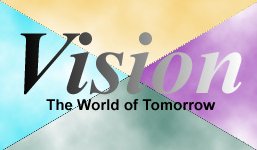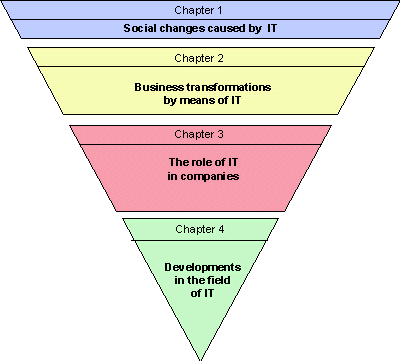
Vision
Introduction |
For whom?
This book is on the one hand intended for managers and staff members of companies, who are strategically involved with changes in their organisations, and on the other hand the book is meant for everybody who is confronted with IT applications, both at work and at home.For thirty years now, IT has given impulses to people and to companies, which have led to changes the effect of which is noticeable up to a social level. New impulses are provided by the current supply of new IT, such as multimedia and virtual reality, and of course the Digital Highway, that will connect people and computers all across the world. It will therefore be a long time before the climax of IT-related social changes is reached. Everybody will have to deal with IT in some form. That is why we have aimed this book at a large public.
Objective of this book
This book presents a broad overview of the subject of information technology. The emphasis is on the growing role of IT as a catalyst of change in companies and in society. The developments in the field of IT are still in full swing. We describe the current state of affairs and from there we look ahead into the future. The book was structured in such a way that it offers interesting material for anyone who is confronted with IT in any way.This book does not provide detailed solutions, but it is rather intended to demonstrate the possibilities for growth and application IT offers to people and companies. With this publication we hope to make a positive contribution to the discussion on the direction in which companies and society will evolve by means of IT, and we hope to inspire the readers in finding new possibilities for the application of IT, both at home and within the organisations in which they work.

Figure 0.1 The main structure of the book The structure
In Chapter 1, we describe the main trends in the field of IT and the consequences they may have. We compare the present situation with the situation of the Industrial Revolution between 1873 and 1896. We expect that IT will become the driving force behind a new socio-economic revolution.In Chapter 2, we provide an overview of the changes that are currently taking place in companies. We do so in the context of the changes in the various business sectors and in society as a whole. We indicate the role IT is now playing. We also indicate the objectives companies may have to apply IT to transform their business processes. Companies can widen their scope by creating new markets through the introduction of new products or services. Companies can also change their relations with customers, suppliers or competitors. Co-oporations may arise in which competitors become partners in new strategic alliances. IT can also be used to enhance the efficiency and the effectiveness of business processes. We provide an idea of the way in which companies go through the learning process with IT and how they can use IT to implement changes in their organisations in a well-balanced way.
In Chapter 3, we provide a more detailed description of the possibilities for companies to apply IT. First, we indicate how IT in combination with telecommunications can support the co-operation between companies and between people. This description is followed by a number of examples of how IT can support business processes.
Finally, in Chapter 4, we shed a light on the developments in the field of information technology. Various technologies are discussed, that are relevant in the light of the applications of IT described in the previous chapters. We describe the current state of the art and the expected further development of each of these technologies.
Reading guide
We have composed the book in such a way that each chapter can be read independently. We do, however, advise the reader to start with Chapter 1. This chapter provides a general overview of the subjects discussed in the following chapters. Chapter 2 is intended for people who are interested in business organisation, and especially in the strategic aspects of the application of IT. Chapter 3 is aimed at those who are interested in the organisation of business processes and in the role IT plays in this matter, for example business consultants involved with Business Process Redesign in combination with IT, or IT consultants who advise on the application of IT in business operations. Chapter 3 requires the reader to have some understanding of the working of IT. Chapter 4 is meant for readers who are interested in IT itself and who want to be informed of important recent developments. This chapter provides background information; each subject can be read independently.Concluding remarks
Whenever it says he or him in this book, one should also read she or her. For the sake of readability, the number of references in the text was kept to a minimum. This may mean that some terms are explained more than once.To keep the book accessible to all readers, the typical IT jargon with its many abbreviations has been avoided where possible. Specific terms are explained in the text as much as possible. In the contributions about the specific business sectors the typical jargon was also avoided or explained as much as possible.
The appendices contain a glossary of a number of terms that are often used and a list of abbreviations.